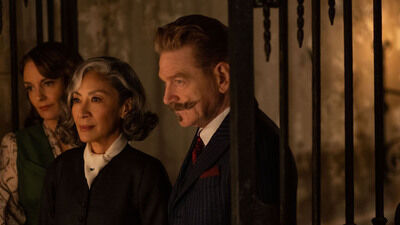Branagh was compared to Orson Welles early in his career for obvious reasons. He was a wunderkind talent who became internationally famous in his twenties and often starred in projects he originated and oversaw. He had one foot in theater and the other in film. He loved the classics (Shakespeare especially) and popular film genres (including musicals and horror). He had an impresario’s sense of showmanship and the ego to go with it.
He’s never been more brazenly Wellesian than he is here. This film has a “big” feeling, as Welles’ films always did, even when they were made for pocket change. But it’s not full of itself, wasteful or pokey; it’s compact and focused, gets in and out of every scene as fast as possible, and clocks in at 107 minutes, including credits. Film history aficionados may appreciate the many acknowledgments of the master’s filmography, including ominous views of Venice that reference Welles’ “Othello” and a screeching cockatoo straight out of “Citizen Kane.” At times, it feels as if Branagh conducted a seance and channeled Welles’ spirit, as well as that of other directors who worked in a black-and-white, expressionistic, Gothic-flavored, very Wellsian style (including “The Third Man” director Carol Reed and “The Manchurian Candidate” and “Seven Days in May” director John Frankenheimer).
Branagh and cinematographer Haris Zambarloukos have also mentioned Richard Brooks’s 1967 adaptation of “In Cold Blood” and Masaki Kobayashi’s “Kwaidan” as influences. Movies just don’t look like this anymore, and it’s a shame, because when they do, the too-muchness can be more engaging than a style that subordinates visuals to plot. The movie deploys fish-eye lenses, dutch tilts, hilariously ominous close-ups of significant objects (including a creepy cuckoo clock), extreme low- and high-angles, and deep-focus compositions that arrange the actors from foreground to deep background, with architecture, bits of furniture, and sometimes actors’ bodies looming in the foreground. Branagh and editor Lucy Donaldson time the cuts so that the more ostentatious shots (such as images of Branagh and Fey as seen through the metal screen of a fireplace, roaring flames in the foreground) are on-screen just long enough for the viewer to register what they see and laugh at how far the movie is willing to go for the effect.
Intriguingly, like post-millennial Michael Mann and Steven Soderbergh movies, “A Haunting in Venice” was shot digitally (albeit in IMAX resolution), and the low-light interior scenes make no attempt to simulate the look of film stock. The images have an unreal hyper-clarity but also a shimmering, otherworldly aspect, especially in tight close-ups where the actors’ eyes seem to have been lit from within.
Available in theaters on September 15th.

